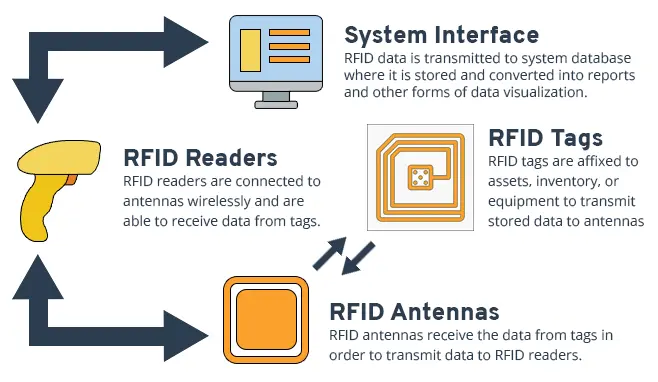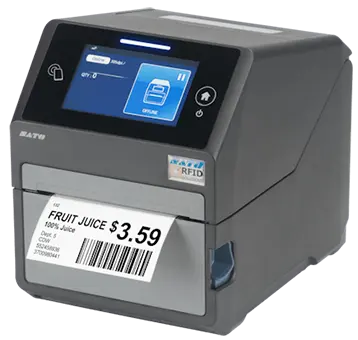
Radio-Frequency Identification (RFID) technology has revolutionized the way businesses manage their assets, track inventory, and enhance operational efficiency. Central to any successful RFID implementation is the RFID printer, a critical component that encodes and prints RFID tags. However, not all RFID printers are created equal, and selecting the right one is paramount for a seamless deployment. In this article, we will delve into the essential features that businesses should consider when choosing an RFID printer to ensure a successful and effective RFID deployment.
Why Add RFID to Your Supply Chain?
Manufacturers stand to gain numerous advantages by integrating RFID (Radio-Frequency Identification) technology into their supply chain operations. Firstly, RFID provides unparalleled visibility and traceability of products throughout the entire production and distribution process. This means manufacturers can monitor inventory levels, track the movement of goods in real-time, and swiftly identify any discrepancies or inefficiencies.
Additionally, RFID drastically enhances accuracy in inventory management. Traditional barcode systems often require manual scanning, which is both time-consuming and prone to human error. In contrast, RFID tags can be read automatically and simultaneously, even in bulk, ensuring precise and efficient inventory counts. This accuracy minimizes the risk of stockouts or overstocking, optimizing inventory levels for cost-effectiveness. Furthermore, RFID enables manufacturers to implement just-in-time (JIT) inventory systems, reducing carrying costs and improving cash flow by ensuring that materials and components arrive precisely when needed. This leaner approach to inventory management can lead to substantial cost savings in the long run.
Overall, the adoption of RFID technology in the supply chain empowers manufacturers with real-time visibility, accuracy, and cost-efficiency, ultimately enhancing their competitive edge in the dynamic marketplace.

How RFID works
Popular RFID Printer Manufacturers
Several reputable brands specialize in manufacturing RFID printers, offering a range of models with various features to cater to different industries and applications. Here are some popular RFID printer brands:
- Zebra Technologies: Zebra is a well-known name in the world of automatic identification and data capture (AIDC) technology. They offer a diverse range of RFID printers suitable for industries like retail, manufacturing, healthcare, and logistics.
- Avery Dennison: Avery Dennison is a global leader in labeling and packaging materials. They offer RFID printer solutions that integrate seamlessly into various industries, such as apparel, retail, and logistics.
- SATO: SATO specializes in providing comprehensive Auto-ID solutions, including RFID printers. Their printers are used in industries like retail, healthcare, manufacturing, and logistics.
- Toshiba: Toshiba offers a range of RFID printers known for their quality and efficiency. They are used in applications ranging from retail and logistics to healthcare.
- Datalogic: Datalogic is a leading provider of advanced data capture and automation solutions. They offer RFID printers suitable for various industries, including retail, transportation, and manufacturing.
- Intermec (now part of Honeywell): Intermec, now under the Honeywell brand, was known for its rugged and reliable RFID printers. These printers were commonly used in industries such as logistics, manufacturing, and retail.
- Printronix: Printronix is a manufacturer of high-quality RFID printers that are widely used in industrial applications, including manufacturing, transportation, and logistics.
- TSC: TSC offers a range of RFID printers designed for different industries, including retail, healthcare, and manufacturing. Their printers are known for their durability and performance.
- Citizen: Citizen is a global provider of barcode and RFID printing solutions. They offer a range of RFID printers suitable for various industries.
Key Features to Look for in an RFID Printer
When selecting an RFID printer, several key features should be considered to ensure optimal performance and compatibility with specific applications.
1. Encoding Capabilities
One of the most crucial features of an RFID printer is its encoding capability. This refers to the printer’s ability to write data to the RFID tag. There are various encoding standards, such as EPC Gen2, ISO 18000-6C, and others. The printer must support the specific encoding standard required for the intended application. Additionally, it should have the flexibility to handle different RFID tag types, including passive, active, and semi-passive tags.
2. Print Resolution and Speed
Print resolution determines the clarity and precision of the printed information on the RFID tag. A higher resolution ensures that text, barcodes, and graphics are sharp and easily scannable. Additionally, print speed is a critical factor, especially in high-volume operations. A printer with a faster print speed can significantly enhance operational efficiency by producing more tags in less time.
3. Connectivity Options
The printer should offer a range of connectivity options to seamlessly integrate into existing IT infrastructures. This includes USB, Ethernet, Wi-Fi, and Bluetooth connectivity. The ability to connect wirelessly can be particularly advantageous in environments where wired connections are impractical or restrictive.
4. User-Friendly Interface
An intuitive and user-friendly interface is essential for easy setup and operation. A clear and straightforward menu system, along with a responsive touchscreen or control panel, ensures that users can quickly navigate the printer’s settings and functions without extensive training.
5. Durability and Reliability
In many industries, RFID printers operate in challenging environments. They may be exposed to dust, moisture, or even harsh chemicals. Therefore, a robust and durable build is essential to ensure reliable performance in such conditions. Additionally, printers with sturdy enclosures and components are less likely to require frequent maintenance or repairs.
6. RFID Antenna Configuration
The printer’s antenna configuration determines its ability to effectively encode and print RFID tags. Printers may have single or multiple antennas, and the configuration should be compatible with the size and type of tags being used. The optimal antenna configuration ensures consistent and accurate tag encoding.
7. Easy Integration with Existing Systems
A crucial aspect of a successful RFID deployment is the ability of the printer to seamlessly integrate with existing enterprise systems, such as Warehouse Management Systems (WMS) or Enterprise Resource Planning (ERP) platforms. This facilitates the flow of data between different parts of the operation and ensures that information is accurate and up-to-date.
8. Scalability and Future-Proofing
As business needs evolve, it’s important that the RFID printer can scale to accommodate increased volumes or new applications. This includes the ability to support additional encoding standards or tag types, ensuring that the investment remains relevant and valuable over time.
Types of RFID Printers
There are several types of RFID printers, each suited for specific applications and environments. Here are the main types:

Example of a desktop RFID printer (SATO CT4-LX)
Desktop RFID Printers
- Description: Desktop RFID printers are compact, user-friendly devices suitable for lower-volume applications. They are commonly used in environments like retail stores, offices, and smaller manufacturing facilities.
- Key Features: These printers offer basic encoding and printing capabilities, and they are often designed for ease of use and space efficiency.
Industrial RFID Printers
- Description: Industrial RFID printers are rugged, heavy-duty machines designed for high-volume and demanding environments. They are typically used in large-scale manufacturing operations, distribution centers, and logistics hubs.
- Key Features: These printers have robust construction to withstand harsh conditions. They often offer faster print speeds, higher resolution, and advanced encoding options.

Example of an mobile RFID printer (Zebra ZQ521)
Mobile RFID Printers
- Description: Mobile RFID printers are portable devices designed for on-the-go printing and encoding. They are commonly used in applications like field service, transportation, and retail.
- Key Features: These printers are compact, lightweight, and battery-powered, allowing for flexibility in various work environments. They often integrate with mobile devices for added convenience.
RFID Label Applicators
- Description: RFID label applicators are specialized machines that automatically apply RFID labels to products or packaging. They are often integrated into production or packaging lines.
- Key Features: These devices are designed for high-speed application and precise placement of RFID labels onto items.
RFID Inlay Converting Equipment
- Description: Inlay converting equipment is used in the production of RFID inlays, which are the core components of RFID tags. This equipment converts raw materials into finished inlays.
- Key Features: These machines may involve processes like laminating, die-cutting, and encoding to create functional RFID inlays.

Example of an RFID card printer (Zebra ZXP Series 7 UHF Printer)
RFID Card Printers
- Description: RFID card printers are specialized devices used to encode and print information on RFID cards, commonly used for access control, identification, and other applications.
- Key Features: These printers are designed to handle the specific dimensions and materials of RFID cards, ensuring accurate encoding and printing.
RFID Print and Apply Systems
- Description: RFID print and apply systems combine the functionality of an RFID printer with an applicator, allowing for both encoding and automatic application of RFID labels onto products or packages.
- Key Features: These systems are often used in high-speed manufacturing or distribution environments where efficiency and accuracy are crucial.
Why Picking the Right RFID Printers Makes the Difference
Selecting the right RFID printer is a critical decision in any RFID deployment. By considering these essential features, businesses can ensure that their chosen printer aligns with their specific needs and supports a seamless and successful RFID implementation. With the right printer in place, businesses can unlock the full potential of RFID technology, optimizing their operations and gaining a competitive edge in today’s dynamic business landscape.


